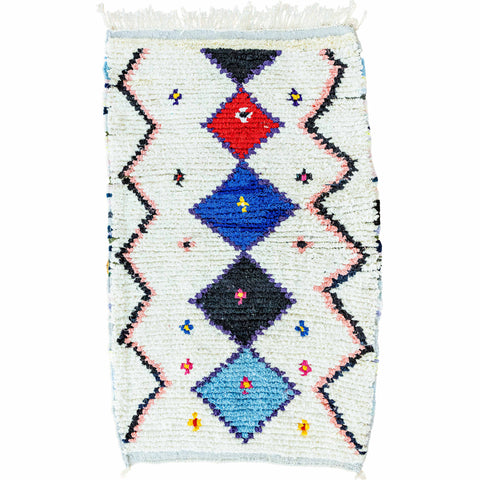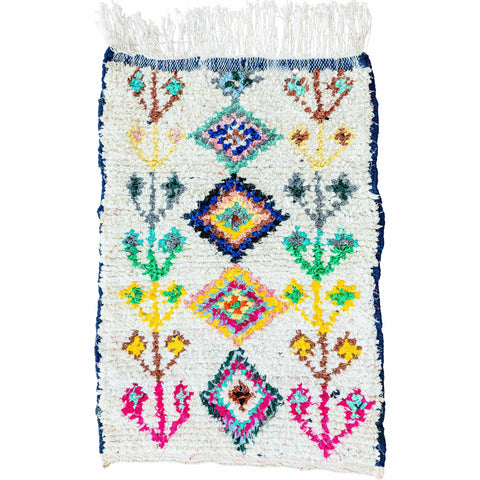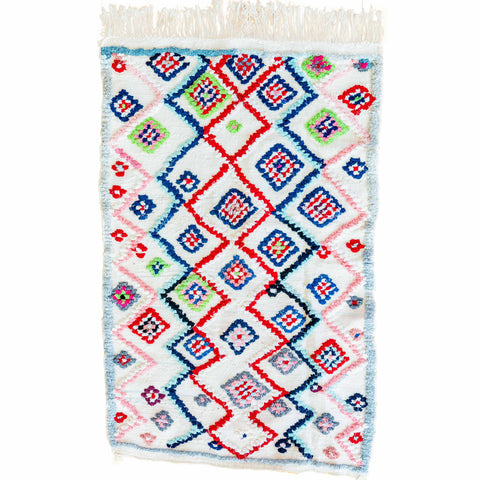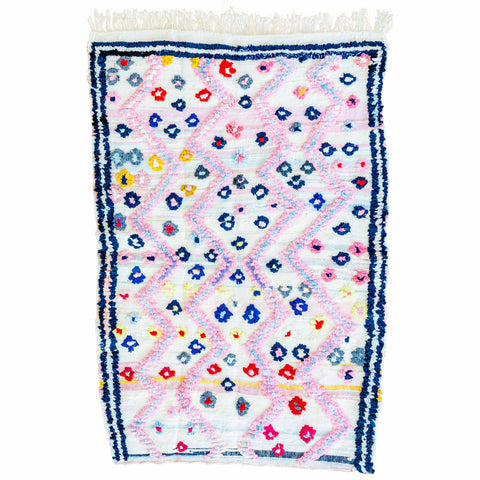What Are Moroccan Rugs? Everything You Need To Know

Crafted by Berber artisans. Curated by decor enthusiasts
You may have heard about fine Moroccan rugs being used to enhance homes, hotels, resorts, restaurants, and office spaces with an upscale appeal. But do you know what they are and where they are made?
There is so much more to these works of art than meets the eye. A story can be found hidden in the details.
What Are Moroccan Rugs?
Moroccan carpets and rugs are textile floor coverings hand-woven in Morocco by indigenous tribal people. Even though the utility is their main purpose in Morocco, many people throughout the world enjoy collecting and decorating with them.
The varying styles of authentic Moroccan rugs are due in large part to the characteristic climate of the region. This gives each individual piece its own unique story, function, and artistic flair.
Exploring each gives us a better appreciation of what makes this traditional rug-making art form special and why they are sometimes used for more than just to cover the floor.
Why Are Moroccan Rugs Popular?
Dynamic color folk art designs and bold geometric patterns are what make these floorcloths famous. These heirlooms have been passed down for generations and are now the hottest trend in decor for interior designers.
Collectors love them for their exotic beauty, simplicity, and distinctive primitivism with a childlike appeal. They anchor any room in an exclusive curated style.

Who Makes Moroccan Rugs?
Every carpet has been traditionally woven in Morocco by people of various tribes. Morocco Berber carpets are handmade by the Berber people in North Africa and the Sahara. The weavers are usually not trained and lack formal artistic instruction. Designs are woven from memory instead of using formal patterns.
The nomadic people often carried their looms from one place to another. This means you will typically not see a Moroccan woven rug wider than seven feet.
Where Are Moroccan Rugs Made?
Traditional Moroccan tribal rugs are also called Berber rugs because they are made by different Berber tribes in North Africa and the Sahara. Every tribe has a distinct style according to local access to natural plants, vegetation, and minerals for dyes, knotting patterns, and the climate of that area of Morocco. The designs found in these Berber rugs from Morocco are ancient being passed down by generations of weavers.
What Are Moroccan Tribal Rugs Made From?
The Berber carpets of Morocco are woven from pure sheep wool in different piles and thicknesses according to the region. Moroccan throw rugs made with a thicker pile are used in the cold and snowy Atlas Mountains area. Lighter Moroccan flat weave rugs are created for the hot climate of the Sahara Dessert.
Each floor covering takes anywhere from 2 weeks to 6 months (depending on the size and complexity) of weaving by hand creating a unique masterpiece on a loom. Every Moroccan area rug is original and considered one-of-a-kind. These tapestries are traditionally made by women using symbolism to weave in her life story.
Today, many types of Moroccan rugs are also mass-produced using a variety of substances such as nylon and Olefin fiber plus wool. The use of synthetic materials has constructed lower quality floor decor at more affordable prices. Some countries are banning this practice to ensure quality and to preserve the uniqueness of each tribal design.
Are Moroccan Rugs Durable?
Rugs from Morocco are high quality making them very durable which is why they are often found in schools, offices, homes, and high traffic areas throughout the world. They are stain-resistant and usually more affordable than plush carpets. Make sure to clean these floor accents every 6 to 12 months to prevent wear patterns.
Are Moroccan Rugs Washable?
Handwoven vintage Moroccan carpets are easy to care for in just a few simple steps. Here is a quick tutorial on how to wash these rugs with no trouble at all.
Step 1: Arrange a clean area to wash the rug.
Step 2: Prepare the floorcloth by hanging it on a close line and beat out the dust and dirt particles.
Step 3: Lay the carpet in the cleaned area and wet it with water. Sprinkle on laundry detergent and rub it gently on the carpet with your hands creating a foam on the surface.
Step 4: Rinse the rug completely of detergent with water.
Step 5: Hang the floor covering up outside to dry in the sun. Do not dry it with a machine dryer.
How Do People Use Handmade Rugs in Morocco?
Berber rugs in Morocco are used for more than just floor coverings throughout the mountainous region of western North Africa. They are created for practical purposes for use in homes and tents, warmth in cold elements, as a tradition passed down for generations, and for storytelling.
Here are a few more ways these tapestries are used in Morocco and North Africa:
- Sleeping mats
- Bed coverings
- Mattresses
- Seating covers
- Blankets
- Saddle blankets
- Burial shrouds
What Are the Moroccan Berber Rug Symbols?
The women who weave Berber rugs add symbolism into their designs that represent birth or fertility. Motifs are used to represent various events and phases in a woman’s life including childhood, virginity, courting, creating a union, pregnancy, birth pains, giving birth, and a newborn child.
The colors used in each textile also have meaning. Red symbolizes strength and protection, blue represents wisdom, yellow stands for eternity, and green means peace.
How Are Moroccan Rugs Made?
The hand-spun cloth Berbers are named after individual tribes. Modern mass-produced Berber carpets are made using a loop pile construction that gives a similar appearance to the knotting of traditionally woven rugs.
Handmade Moroccan carpets are still actively woven in many rural areas of Berber countries. This is still the primary income for many families that sell them in local markets and to merchants and tourists. The handwoven rugs are more unique using cultural designs and natural materials.
These carpets can be very thick with a heavy pile or flat woven and light to reflect the cold or hot region of which they are made. Each tribe of generational rug weavers has developed its own distinctive designs paired with various weaving and embroidery styles.
The three major weaving styles commonly found in Moroccan rugs include knotted, flat weave (no knots), and weft substitution.
What Are the Different Types of Moroccan Rugs?
Each rug reflects the unique flavor of the different Berber tribes. The regional climate and access to materials are what show off their exceptional flair. Here is some additional insight into the most popular weaving traditions of the Berber tribes and how they make every carpet truly their own.
1. Azilal Rugs
The single-knotted Azilal rugs in the high Atlas Mountains of the central province of Azilal tell stories through the bold use of color and intricate symbolic patterns. Ancestral myths are incorporated into the textiles using archaic images and symbols.
The hand-knotted Moroccan rug base is usually cream, ivory, white, or neutral color from the natural wool used paired with brightly colored wool dyed with regional flowers and vegetation.
More geometric shapes with a plushness and heavy pile are what the Azilals typically incorporate into their handmade carpets. If you love to dress up a room with more spunk and spice, the Azilal carpets are right for you.
2. Boujad Rugs
Deep red, pink, purple, and orange hues are used regularly in Boujad rugs of the Central Plains region. Typical knotting practiced by Berber tribes with a tighter knot is used requiring less wool.
These carpets are famous for their geometric patterns with colors made from the natural dyes of flowers, henna, berries, and leaves. They are so colorful and trendy that your friends and neighbors might want one too.
3. Beni Ourain Rugs
Muted natural cream color tones are traditionally used in the Ben Ourain tribal rugs of the Middle Atlas Mountains. The shades range from white to cream in a monochromatic style lending themselves readily to minimalist homes.
Each Beni rug can be found with black or dark brown geometric lines and patterns. The design is often mismatched or asymmetrical giving it a more personal touch and added charm. Rare Benis can be found in turquoise and taupe colors.
Famous designers who loved using Beni Moroccan rugs include Le Corbusier and Frank Lloyd Wright. These carpets are best suited for those who love the trendy timeless look.
4. Beni Mguild Rugs
A plush, thicker weave is used in the Beni Mguild rugs of the colder climate in the western Middle Atlas region. The carpets are woven on a vertical loom using deep shades of purple, blue, red, and brown.
They are usually flipped according to seasonal changes using the plush side during the colder months and the flat surface during the warm months. If you love versatility, a Beni Mguild carpet may be right for you.
5. Boucherouite Rugs
The Moroccan Boucherouite rugs have playful and visually captivating designs being crafted from scraps of fabric and clothing when wool is not accessible. This is due to the transition from nomadic herding to modern forms of employment.
The Berber carpet weavers recycle materials creating practical echo friendly rag rugs in bright colors that are warm and durable. These exceptional carpets will be your favorite if you love charm and vivid colors.
6. Mrirt Rugs
The lush texture of high-density wool and deep colors are what make Mrirt Moroccan rugs so exquisite. The Beni M'rirt tribe of the Middle Atlas call their creations "shadow carpets" using shadow wool vegetable colors instead of design patterns.
Mrirt carpets are woven with pure New Zealand wool of the highest quality. The natural fibers resist stains, reduce sounds, and are capable of withstanding a fire.
If you enjoy the soft texture of warm natural wool, then a Mrirt rug is the perfect fit for you creating the immediate feeling of well-being.
Timeless Trendy Moroccan Rugs
Modern interior designers of the western world began to embrace Moroccan tribal rugs more in the mid-twentieth century. With the increase in popularity of Bohemian and boho style decorating, they have now been loved and embraced by all.
Natural aging increases the value of vintage Berber rugs over time. You can tell they are truly vintage by a natural fade, imperfect fringe, and the fabric will be frayed. Remember, these masterpieces were meant for use and not for display only.
This 2,000-year-old rug weaving tradition has produced remarkable rug art investment pieces for your home to be enjoyed for a lifetime that can be passed on to the next generation.
Where Can I Buy Berber Moroccan Rugs?
Coco Carpets has one of the largest collections of Moroccan rugs and rug art home decor for purchase online. None are mass-produced and have been made only by hand.
These antique Moroccan rugs are truly one-of-a-kind found only by traveling to various regions of Morocco to meet with the tribal people who make them. We know how to find the best handmade Morocco accent rugs in the world and can’t wait to see them bring new life to your rooms.

































